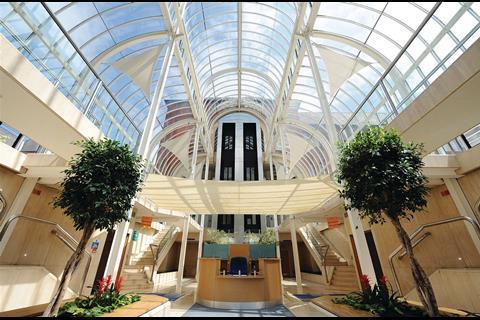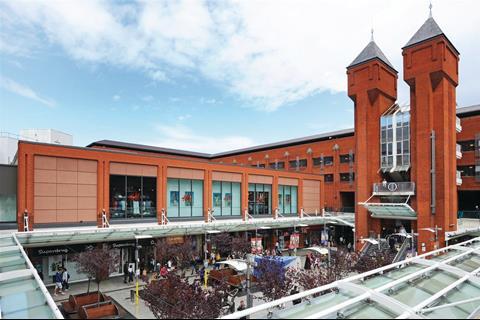Keeping shopping destinations relevant and exciting in order to attract the hordes in today’s tough economic climate is an ongoing challenge for landlords. Christine Eade considers the options available.
West London shoppers treat the Ealing Broadway Shopping Centre as a place of convenience. They buy cheap clothes from Primark or groceries from Tesco, while saving the big day out either for nearby Westfield London or for Oxford Street.
Yet if Ealing Broadway is so mundane, why did Wereldhave, the Netherlands property investment vehicle, buy the 275,000 sq ft centre for £155.5m six months ago?
It was also £5.5m above the guide price.
The answer, according to Wereldhave UK managing director Andrew Turton, is that it has underused open space and has the scope to replace shops with restaurants.
This is the meaning of asset management: fresh pairs of eyes look at familiar shopping centres and see dead-end malls, small units that must be knocked together to create big stores for national multiple retailers and turning failed shops into restaurants.
Space invaders
Legal & General Property developed and owned Ealing Broadway for 27 years before Wereldhave’s acquisition. Turton describes it as an underused asset: “There are 16 archways on the outside of the centre. In any other European city they would be used as coffee shops, and that is what we propose to do. We have instructed Haskoll not in the guise of an architect, but as an interior designer to use this space more effectively.”
Turton also considers that if restaurants move into some of the five empty shops in the centre, the restaurateurs will pay about the same rent as the out-going retailers. He adds that the London Borough of Ealing has allowed Wereldhave to combine a vacated Sofa Workshop unit with the neighbouring shop to create a 6,000 sq ft restaurant. The restaurant will pay annual rent of £80,000-plus turnover.
“Councils will want to know broadly what else is out there in competing provision for A3 use,” says Turton of the application for change of use. “But I find councils have been open to a wide range of uses.” The biggest untapped Ealing resource is the 21,405 sq ft open-air town square in the centre of the scheme. Turton describes it as having “a statue of some kids and a few benches which is ridiculous for a shopping centre in London”. His plans include events in the square or opening kiosks for beauticians to give manicures or tidy eyebrows with threading treatments.
Developing stores in such open-air squares adds to centres’ rental income. Capital & Regional derives an income of £3.91m a year at The Mall Blackburn, after filling in the square with stores including H&M, Next and Primark two years ago.
A change of tack
But sometimes, asset management means stopping the rot. Capital & Regional managing director of shopping centres Mark Bourgeois cites the example of the Newton Mall, part of The Mall, Middlesbrough, which it sold in September. Four retailers – multiples and independents – were paying £425,000 a year in rent in 2007. But as the retailers shut the stores, the rent fell to £150,000.
Capital & Regional knocked the four units into one and let them to 99p Stores, which pays £300,000 a year in rent.
Yet the alchemy needed to turn neglected space into income-producing destinations has its fair share of failures. Aberdeen Asset Management tried to create a new unit at Lion Yard, Cambridge, on the site of Cambridge City Council’s ground floor public toilets. It promised new first-floor toilets, but protestors standing outside the existing facility collected more than 10,000 signatures against the proposals. The city council refused to grant planning permission, acknowledging fears that the disabled might not make it to the first floor if the lifts broke down.
Aberdeen Asset Management director Simon Andrews says: “It has been a bit of a saga and we are still in active discussion. We can’t talk about an abortive pre-let, because we didn’t have a pre-let in place. But we would have been able to create a big store of 5,000 sq ft. Now retailers are left alongside the public toilets, which is not the most attractive place for retailers to be situated.”
Aberdeen was so confident it could relocate the toilets that it took over the lease to Currys’ ground floor store and had taken back HMV’s lease to create space for lifts and stairs to the upstairs facilities. Andrews says now the plan is thwarted, he awaits funding from Aberdeen to divide Currys into three units and HMV into four. Rents have fallen since Currys and HMV left Lion Yard. Andrews estimates that Cambridge rents peaked in 2007, with zone A rents since having fallen by £50 per sq ft.
Yet even after reconfiguring stores and replacing failing retailers with restaurants, asset management can only go so far. In a time of falling rents, a proactive landlord must accept that until the economy improves, many shopping centres may have to come to terms with the fact that they will struggle to reap the rewards that were taken for granted five years ago.
Parkgate Shopping, Rotherham

Asset management on out-of-town retail parks often means little more than simply dividing a 20,000 sq ft store in half, allowing the existing retailer to downsize, and then re-letting the surplus space.
At a time of stagnant and falling rents, this in itself will not add value to a retail park. Instead, the landlord reaps the benefit when the downsized retailer constructs a mezzanine floor to display merchandise upstairs. The retailer pays for the cost of installing the mezzanine, but reaps the benefits of extra sales floor space, an improved store environment and potentially greater footfall. When the lease ends, the store plus free mezzanine reverts to the landlord.
British Land did this a couple of years ago at Parkgate Shopping retail park in Rotherham, where PC World and Currys were amalgamated into the existing Currys store. Dixons, the tenants of both, put in a mezzanine, while the PC World store was re-let to Asda Living.
Rotherham Metropolitan Borough Council could have refused consent for the mezzanine, but as British Land head of retail asset management Ben Grose says: “We have a good relationship with Rotherham, and they saw benefits to the town.”
When Dixons’ lease ends the mezzanine could be torn down under the reinstatement provision in the lease. But Grose says: “I don’t think a landlord would ask for that. Both parties would say it should remain in situ.” And thus, the landlords get something for nothing.
An architect’s view
Should small stores on the upper mall of a shopping centre pay low rents? No, get rid of them, some say. This is the kind of asset management advice that Trevor Colman, founder of Colman Architects, gives to landlords “Small shops don’t make a critical mass, and they become a liability,” says Colman. He maintains that even the small stores on an upper mall that shoppers walk past before entering a multi-storey car park don’t necessarily work well, despite the footfall.
Knocking through the ceilings of the stores on a lower mall, thus leasing double-height units, has several benefits. From the landlords’ perspective there are no upper malls to clean or light, so they can reduce service charges for tenants, says Colman. The creation of these larger, double-height units often means more scope for retailers to introduce newer and inspiring store formats, potentially boosting opportunities, providing more appealing stores for shoppers, and improving the image of the centre as a whole. What’s more, the improved units come with a higher rental price tag – which goes towards increasing the value of the whole centre for the landlord.
The upper mall space can also be used to accommodate restaurants. Colman cites the example of the Quadrant shopping centre, Swansea, where the centre manager’s office was converted into Welsh restaurant chain Trenchers. Dead space was turned into a rentable, profitable area.




























No comments yet